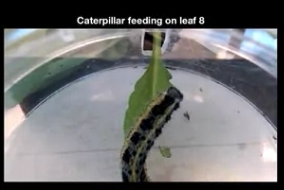Plants use leaf to leaf electrical communication to spread the word that an insect is attacking.
Recent research proved that leaves being damaged by insects can send out electrical signals to warn other leaves to defend themselves, which they do by defense gene expression and …drooping!
Dr Andrzej Kuranda, a plant electrophysiology expert now working for Vivent, the Swiss-based deep tech company, carried out the work during his post-doc at the University of Lausanne in the lab of Ted Farmer and recently published the findings in PNAS.
Images of the carnivorous Venus Fly Trap snapping shut to engulf a poor fly that landed in its `jaws’ or the curling (and sometimes collapse) of the delicate fronds of a Mimosa plant in response to touch, are well known and several theories exist as to how that defense mechanism really works, including one that electrical signals spread through part of the plant.
Andrzej’s work has shown that an insect damaged Arabidopsis leaf (a plant often used by biologists as a `model plant’) sent out electrical signals, when specific mid-vein parts of the leaf were being damaged, to other leaves, with the involvement of the xylem, causing those leaves to droop. So, one leaf was warning the other to go into defense mode. The researchers were able to measure the electrical current and movements of the plant and see it on a monitoring screen as it happened in real-time.
Have a look at an intriguing time-lapsed video in the full paper from PNAS (https://www.pnas.org/content/116/51/26066 ) of a caterpillar munching on one leaf of an Arabidopsis plant with resulting electrical signals received by a different leaf shown on the monitoring equipment, which then caused it to droop.

Electrical signals from wounding by a caterpillar
Vivent the swiss biosignals pioneer realised some years ago the importance that harnessing and decoding electrical signals would have for future crop production. They designed an innovative device -PhytlSigns to translate those signals into meaningful information for researchers and growers, in the form of super-fast alerts of attack (before visual symptoms) and diagnosis of the problem.
Go to www.phytlsigns.com to find out more.

